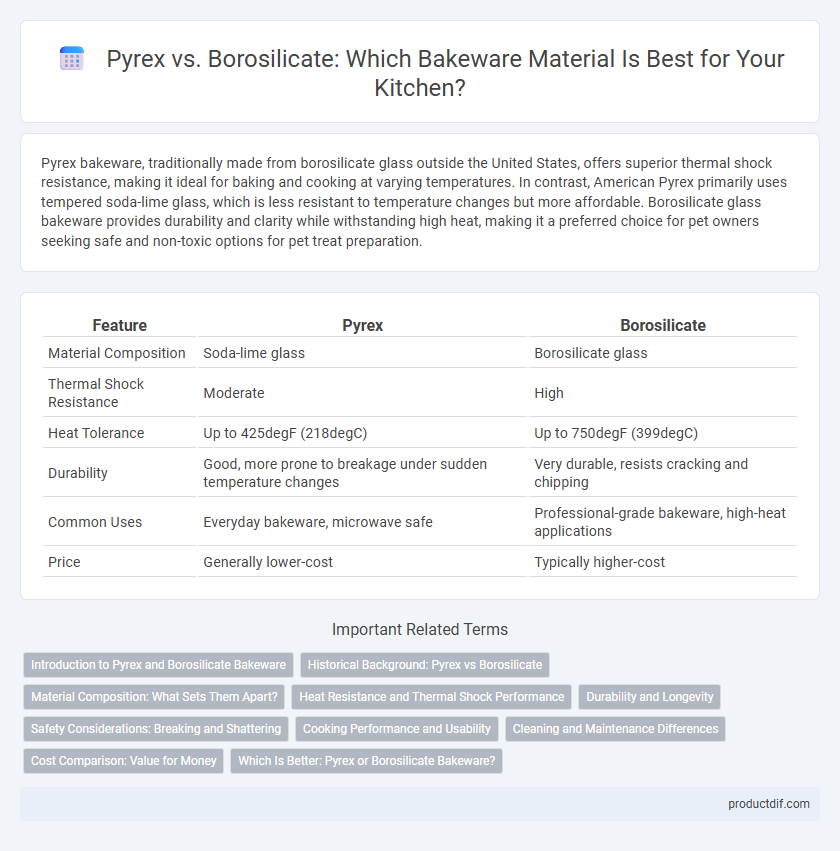Pyrex bakeware, traditionally made from borosilicate glass outside the United States, offers superior thermal shock resistance, making it ideal for baking and cooking at varying temperatures. In contrast, American Pyrex primarily uses tempered soda-lime glass, which is less resistant to temperature changes but more affordable. Borosilicate glass bakeware provides durability and clarity while withstanding high heat, making it a preferred choice for pet owners seeking safe and non-toxic options for pet treat preparation.
Table of Comparison
| Feature | Pyrex | Borosilicate |
|---|---|---|
| Material Composition | Soda-lime glass | Borosilicate glass |
| Thermal Shock Resistance | Moderate | High |
| Heat Tolerance | Up to 425degF (218degC) | Up to 750degF (399degC) |
| Durability | Good, more prone to breakage under sudden temperature changes | Very durable, resists cracking and chipping |
| Common Uses | Everyday bakeware, microwave safe | Professional-grade bakeware, high-heat applications |
| Price | Generally lower-cost | Typically higher-cost |
Introduction to Pyrex and Borosilicate Bakeware
Pyrex bakeware, originally made from borosilicate glass in the United States, offers exceptional thermal shock resistance and durability for everyday baking needs. Modern Pyrex in the U.S. is primarily made from tempered soda-lime glass, while borosilicate glass remains popular in Europe and other regions due to its higher resistance to rapid temperature changes. Borosilicate bakeware provides superior strength and longevity, making it ideal for recipes requiring extreme temperature fluctuations.
Historical Background: Pyrex vs Borosilicate
Pyrex, originally introduced by Corning in 1915, was initially made from borosilicate glass, prized for its thermal shock resistance in bakeware applications. In the 1990s, American-made Pyrex shifted to tempered soda-lime glass, altering its heat tolerance compared to traditional borosilicate counterparts used in European bakeware. Understanding this historical transition helps consumers choose between durability and thermal performance in bakeware materials.
Material Composition: What Sets Them Apart?
Pyrex bakeware is typically made from tempered soda-lime glass, which offers durability and affordability but can be more susceptible to thermal shock compared to borosilicate glass. Borosilicate glass, composed of silica and boron trioxide, provides superior resistance to temperature fluctuations and chemical corrosion, making it ideal for high-heat baking and laboratory settings. The distinct chemical composition of borosilicate glass results in enhanced thermal stability, setting it apart from traditional soda-lime Pyrex products.
Heat Resistance and Thermal Shock Performance
Pyrex bakeware, originally made from borosilicate glass, offers excellent heat resistance and superior thermal shock performance, allowing it to withstand rapid temperature changes without cracking. Modern Pyrex in the U.S. is made from tempered soda-lime glass, which has slightly lower heat resistance and thermal shock durability compared to true borosilicate glass. Borosilicate bakeware remains preferred for professional chefs and bakers requiring maximum thermal stability during extreme temperature shifts.
Durability and Longevity
Pyrex bakeware made from tempered soda-lime glass offers strong resistance to thermal shock but may be more prone to scratching and chipping over time compared to borosilicate glass. Borosilicate glass bakeware possesses superior durability against sudden temperature changes due to its low thermal expansion coefficient, extending its longevity under frequent use. Choosing borosilicate bakeware ensures enhanced resistance to cracking and breaking, making it a preferred option for long-term durability in baking applications.
Safety Considerations: Breaking and Shattering
Pyrex bakeware is made from tempered soda-lime glass, which offers strong resistance to thermal shock but may shatter into large, sharp pieces upon sudden temperature changes, posing safety risks. Borosilicate glass, known for its superior thermal stability, minimizes the likelihood of breaking or shattering due to rapid temperature fluctuations, enhancing user safety in high-heat baking scenarios. Choosing borosilicate bakeware reduces the risk of dangerous breakage, making it a safer option for frequent exposure to extreme oven temperatures.
Cooking Performance and Usability
Pyrex bakeware, traditionally made from soda-lime glass, offers excellent heat distribution but is more prone to thermal shock compared to borosilicate glass, which resists sudden temperature changes and is ideal for rapid heating and cooling. Borosilicate glass bakeware provides superior durability and versatility in the oven, microwave, and dishwasher, ensuring consistent cooking performance without warping or cracking. Both materials are non-reactive and maintain the flavor integrity of baked goods, but borosilicate's enhanced resistance to temperature fluctuations improves usability for diverse cooking applications.
Cleaning and Maintenance Differences
Pyrex bakeware, typically made from tempered soda-lime glass, requires gentle cleaning to avoid scratches and sudden temperature shocks that can cause breakage. Borosilicate glass bakeware, known for its higher thermal resistance, withstands more rigorous scrubbing and dishwasher cycles without damage, making maintenance easier. Both types benefit from avoiding abrasive cleaners, but borosilicate's durability offers superior longevity with less frequent replacement.
Cost Comparison: Value for Money
Pyrex bakeware, often made from tempered soda-lime glass, usually comes at a lower price point compared to borosilicate glass, making it a budget-friendly option for everyday baking needs. Borosilicate glass, known for its superior thermal resistance and durability, tends to be more expensive but offers greater longevity and resistance to thermal shock, potentially saving money over time. When evaluating value for money, consider the initial cost of Pyrex versus the long-term benefits and reduced replacement frequency offered by borosilicate bakeware.
Which Is Better: Pyrex or Borosilicate Bakeware?
Pyrex bakeware, originally made from borosilicate glass but now primarily manufactured using soda-lime glass in the U.S., offers affordable options with good thermal resistance but can be more prone to sudden breakage from thermal shock. Borosilicate bakeware retains superior durability and can withstand rapid temperature changes due to its low thermal expansion, making it ideal for professional and precision baking. For those prioritizing longevity and resistance to temperature fluctuations, borosilicate bakeware is generally considered better, while Pyrex may appeal to budget-conscious home bakers.
Pyrex vs Borosilicate Infographic

 productdif.com
productdif.com